June Market Report
- May proved another difficult month for the fine wine market as major Liv-ex indices declined across the board – though the decline seems to be slowing.
- The Rest of the World (60) basks in the sun as the index rose 0.8% last month.
- We look at Jed Dunnuck’s top-scoring Bordeaux 2005s – which he calls ‘an exceptional, singular year of blockbuster, powerful wines.’
- A strike from within as Michel Rolland shares his opinion regarding the ‘historic crisis’ facing Bordeaux.
- The Liv-ex Fine Wine 1000 recorded its 19th consecutive negative month in May 2024, down 19% from its high of October 2022 – a technical analyst’s view.
- Year-on-year the Champagne 50 is down 13.7% with new Champagne releases falling flat.
Introduction
Not out of the woods yet
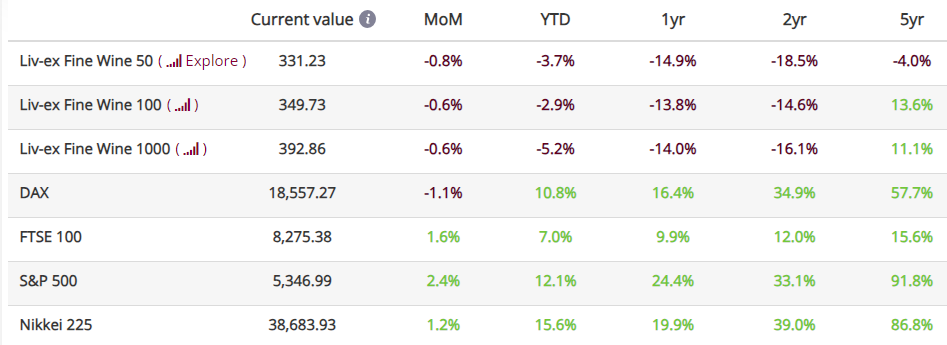
May proved another difficult month for the fine wine market as major Liv-ex indices declined across the board.
The Liv-ex Fine Wine 100, the industry benchmark, fell 0.6% month-on-month following its 1.3% drop in April. The Liv-ex Fine Wine 50, which tracks the movement of the First Growths and is updated daily, dipped 0.8% in May, also an improvement from its 1.3% fall the previous month.
The Liv-ex Fine Wine 1000, which tracks 1,000 wines from across the world, mirrored the Liv-ex 100 and fell 0.6% month-on-month.
There were pockets of strength, however, as the Rest of the World 60 and the California 50 both rose 0.8% in May. The Champagne 50 only dipped 0.2% month-on-month, perhaps buoyed by an uptick in sales as summer descends upon us. On the other hand, the recent high-performing Italy 100 recorded its second biggest fall last month since January 2023, dropping 1.5% in May.
Following a whirlwind of an En Primeur campaign, the picture for Bordeaux is mixed. The Bordeaux 500 recorded a 0.7% fall month-on-month, the Right Bank 100 faring better than the Left Bank 200: the former dipped 0.4% in May compared to 0.6% for the Left Bank. Interestingly, the Bordeaux Legends 40 was one of the worst performers last month, falling 1.4% month-on-month.
Activity on the secondary market was a little subdued in May as trade value and volume dipped month-on-month, as did the number of LWIN7s (labels) and LWIN11s (individual wines) traded. The En Primeur aftermath will reveal whether buyers deem the price cuts deep enough to return en masse – we’re waiting with bated breath.
Major Market Movers
The Rest of the World (60) basks in the sun
While this could be a cruel headline aimed at those au fait with the British weather forecast, it does in fact reflect the movements of the fine wine market last month. Indeed, one of May’s success stories was the Rest of the World 60, which rose 0.8% month-on-month.
The index, which tracks the performance of the ten most recent physical wines of six wines from Spain, Chile, the USA and Australia, was particularly buoyed by its Californian components. In fact, the California 50 (not a sub-index of the Liv-ex 1000 or of the ROTW 60) also rose 0.8% in May.
Aside from Opus One 2019, all the best performing Californian wines in the index are from 2016 or older. By contrast, Dominus 2018 was the worst performer in the Rest of the World 60 last month, down 8.2%, closely followed by Screaming Eagle 2019 (-8.1%) and Screaming Eagle 2020 (-4.5%).
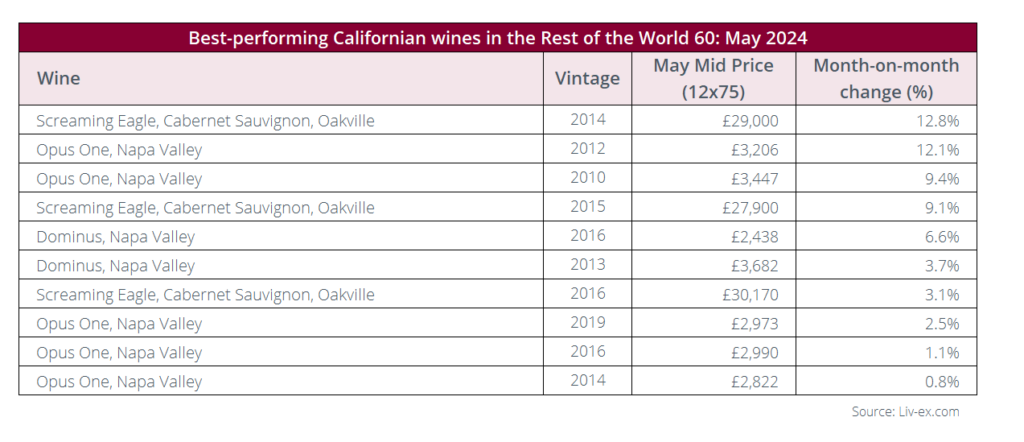
Of the top ten best Californian performers, five were vintages of Opus One: the 2012 (12.1%), 2010 (9.4%), 2019 (2.5), 2016 (1.1%) and 2014 (0.8%). Opus One is the second-most traded Californian producer in terms of value in 2024 so far, accounting for 14.9% of US wines traded.
Screaming Eagle took the top spot, both as the best performing Californian wine in the Rest of the World 60 and as the most traded US producer in 2024 (36.1%). Similarly to Opus One, it was older vintages of the wine that performed best in May, the most recent featuring on the list being 2016. While they are down on a two- and one-year basis, Screaming Eagle 2016 is up 14.3% over five years, the 2014 is up 18.9% and the 2015 up 10.7%. Buyers are thus seemingly focusing their attention on older, scarcer Californian wines which have proven their worth.
Looking at Californian trades on the secondary market over the last two years, the first quarter seems to represent a peak of activity for the region. While first quarter trade by value in 2024 was lower than it was in previous years, the characteristic rebound was noticeable, buoyed by much-anticipated releases from Harlan Estate and Screaming Eagle and a strong dollar.
Will this momentum carry into the latter part of the year? Even if it doesn’t in terms of trade numbers, it seems spirits (or rather, fine wine) are rather high across the pond.
News Insight
A strike from within
Complaints about Bordeaux are not unusual these days – merchants and buyers alike have made their feelings heard about recent En Primeur campaigns, whose high prices and sometimes disappointing quality (2021, we’re looking at you) left a slightly bitter taste in the mouths of collectors.
What’s rarer, however, is when the complaints come from Bordeaux itself. Recently, Michel Rolland expressed his opinions regarding the ‘historic crisis’ facing the region in The Times. The renowned and highly influential oenologist has two bones to pick with Bordeaux producers. The first is pandering to a ‘mistaken belief that consumers no longer wanted classic, full-bodied claret’ and producing lighter wines he deems ‘almost indecent in Bordeaux’.
The second, and one we feel more qualified to comment on, is marketing and pricing their wines assuming the superiority of Bordeaux, which Rolland feels is done ‘with a certain condescension’. In his eyes, Bordeaux’s pricing is akin to proclaiming ‘We are the most beautiful. We are the best’, regardless of the wines’ quality, the state of the fine wine market and the wines produced everywhere else in the world.
Is price the ultimate sign of Bordeaux’s ‘arrogance’? If so, releasing the 2023s, a good vintage but by no means a great one, at a price on average 21.5% lower than the previous one seems almost modest. However, with the Bordeaux 500 down 13.4% in the last 12 months, not to mention the ‘warehouses full of unsold claret’ from the last two difficult En Primeur campaigns and the fact that prices for the 2022s were up 20.8%, that does seem a little bold.
Can the largest chateaux in the region muddle through based on reputation and great wine alone? If the volumes of young Bordeaux on the market are anything to go by, that might prove difficult. What’s more, Michel Rolland seems to think some chateaux are even giving up on the latter, which doesn’t bode well.
Critical Corner
Jeb Dunnuck on Bordeaux 2005
In a report titled ‘Reaching for greatness’, wine critic and writer Jeb Dunnuck pays tribute to 2005 in Bordeaux, which he calls ‘an exceptional, singular year of blockbuster, powerful wines’.
His feelings are reflected in his scores, as he awarded no fewer than 11 100-point scores to wines from the vintage, and a further two 99 points.
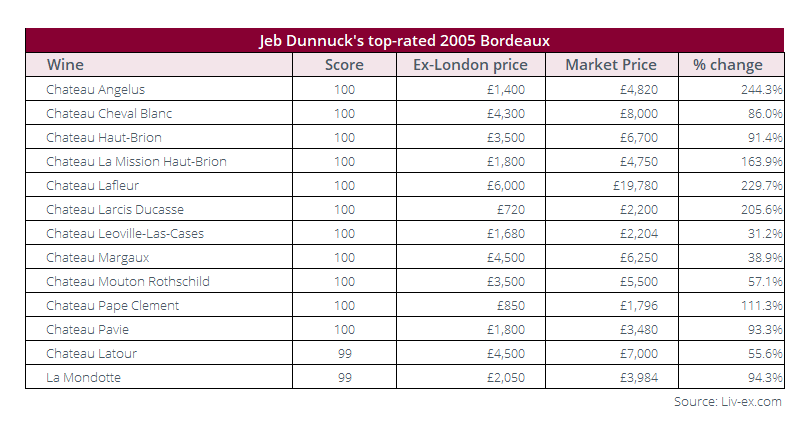
Aside from the myriad of perfect scores, what’s striking about these wines is their phenomenal rise in value. Almost 20 years on, Château Angélus 2005’s Market Price is 244.3% above its ex-London release price. The wine was awarded 100 points from Robert Parker back in 2015, and was recently awarded another 100 points from Lisa Perrotti-Brown MW.
Château Angelus 2005 trades on Liv-ex
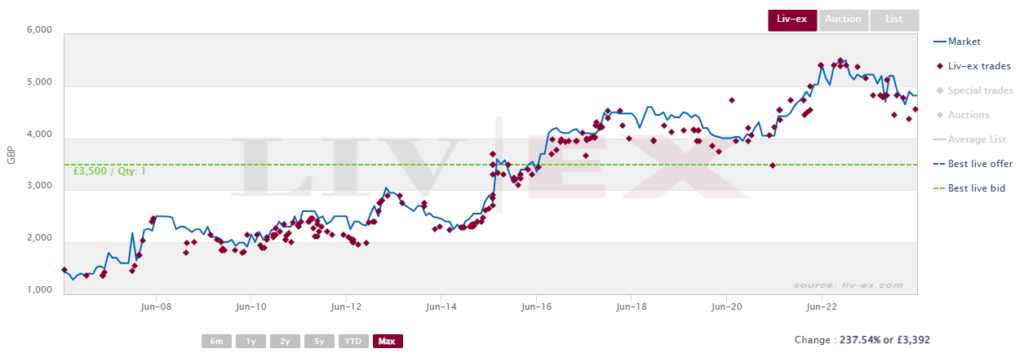
Similarly, Château Lafleur and Château Larcis Ducasse 2005, both fellow Robert Parker 100-pointers, are up 229.7% and 205.6% from their release price respectively. The most modest rise in value was Château Léoville-Las-Cases 2005, up 31.2% from its international release price, a result not to be sniffed at – and perhaps a wine to look more closely at?
In his report, Dunnuck deplores the fact that producers increasingly choose to ‘produce solid (even outstanding), predictable, safe wines’, calling it ‘a smart financial decision in some cases’ but unlikely to produce a great wine (sounds familiar? ). But if the 2005s are anything to go by, this ‘predictable’ production approach is not the only one to adopt to ensure a solid return on investment. So far, the ‘safe’ younger Bordeaux have far from enjoyed the exponential growth of their older counterparts.
Chart of the Month
The Liv-ex 1000 remains firmly bearish
The Liv-ex Fine Wine 1000 recorded its 19th consecutive negative month in May 2024, down 19% from its high of October 2022.
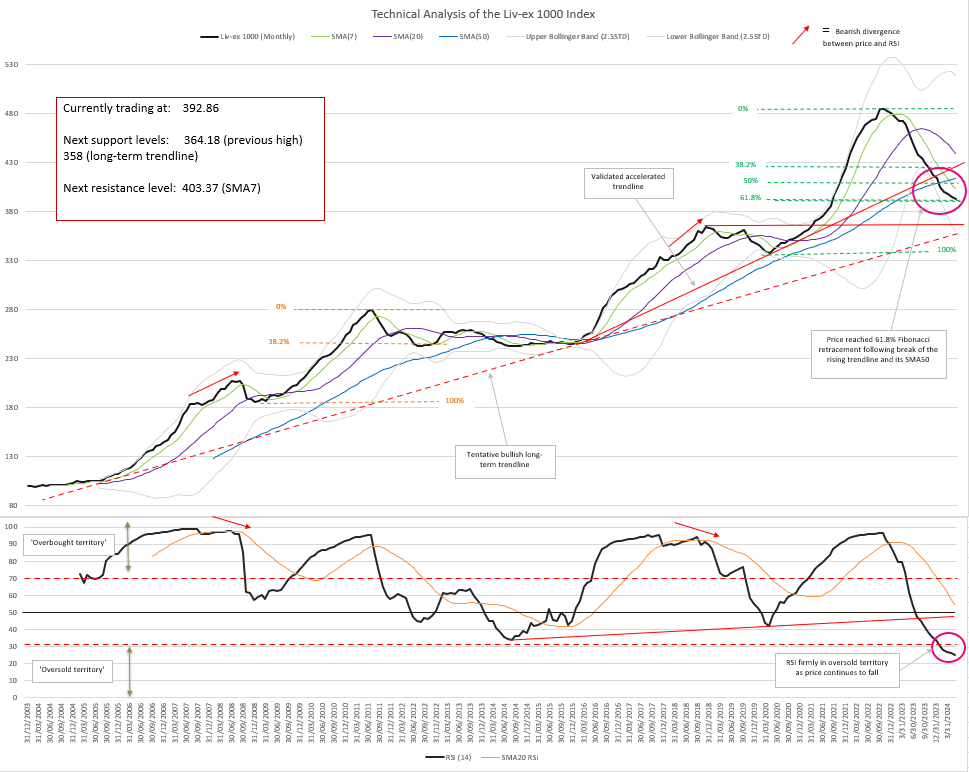
The successive breaks of the ascending accelerated trendline and of the Simple Moving Average 50 Months (SMA50) did not trigger any reversal reaction in the price action. On the contrary, the price has accelerated to the downside, as evidenced by the Relative Strength Index (RSI) which is now firmly sitting in ‘oversold territory’, something we had not seen since the index’s inception.
The next area of support is at 364.18 (in other words, the index’s 2018 highs). This support level will intersect with the long-term rising trendline, which isn’t validated yet, in the next two to three months. This new convergence area is a strong contender for potential support.
At this stage, it is unclear whether the price will reach these levels without retracing first. While the RSI’s momentum remains extremely bearish and the lower Bollinger Band (BB) shows no sign of contracting (which could be interpreted as a sign of price stabilization), we also note that the price has now retraced exactly 61.8% (a very important Fibonacci level) of the most recent wave up from April 2020. This, and the fact that the SMA50 is still rising, could indicate that the index’s medium-term bullish trend is intact.
For now, the Liv-ex Fine Wine 1000 remains firmly bearish. However, technical analysis does point towards some price consolidation at or close to the current levels. We will monitor whether the Bollinger Bands start to contract, the RSI slows down, and whether the 61.8% Fibonacci level provides support for the index.
Should any of this happen, proponents of technical analysis wouldn’t discount a pull-back to the SMA50 or the accelerated trendline, perhaps before the index resumes on its bearish short-term trend.
Final Thought
New Champagne releases are falling flat
As mentioned at the start of this report, the Champagne 50 was one of the better-performing Liv-ex indices last month, falling just 0.2% in May. Year-on-year, however, the index is down 13.7%, and it has fallen 25.4% since its peak in October 2022.
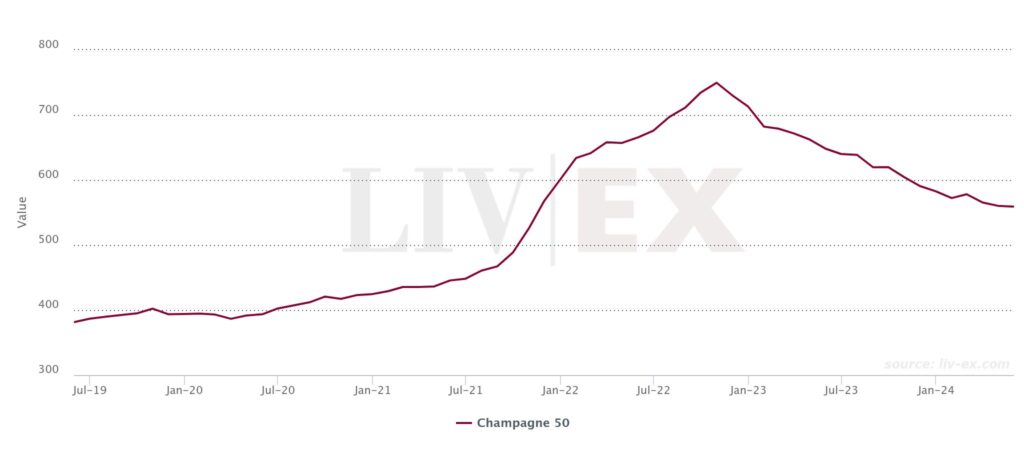
Year-to-date, all bar 13 of the Champagne 50’s components are down. The worst performers in the index since the start of the year are from a range of labels and vintages, making it hard to identify the main culprits for this downward movement.
But in terms of new releases’ performance, there is a ‘before’ and ‘after’ 2022, back when Champagne prices bubbled from the demand. Take Dom Pérignon 2013, which was released in January 2023 for £1,830 per case, 38.6% above the higher-rated 2012’s release price. The wine is now trading around the £1,500 per 12×75 mark.
Dom Pérignon 2013 trades on Liv-ex
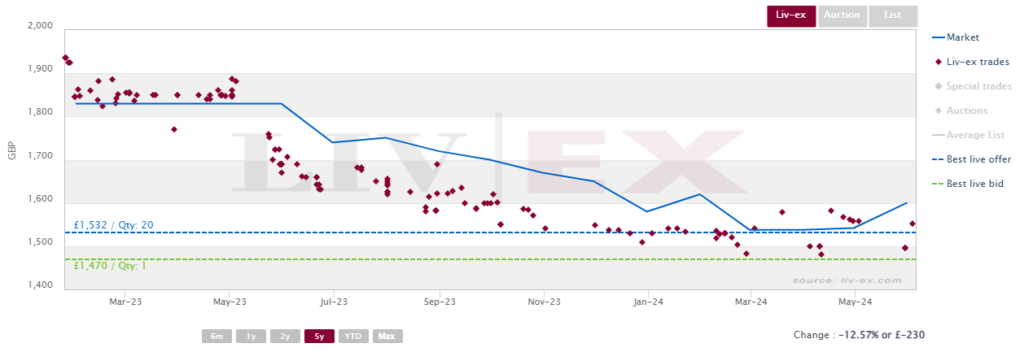
By contrast, Dom Pérignon 2012 was released at £1,320 per case in September 2021. While the wine’s Market Price has been on a downward trend since the latter half of 2022, it benefited from the frenzy of demand and subsequent price increases, its Market Price peaking at £1,990 per case in October 2022. The wine is currently trading just above £1,500 per case
Other wines released since the start of the downturn have suffered a similar fate to Dom Perignon 2013: Louis Roederer Cristal 2015, released in April 2023 at £2,600 per case, has been on a downward trajectory since its release.
Louis Roederer Cristal 2015 trades on Liv-ex
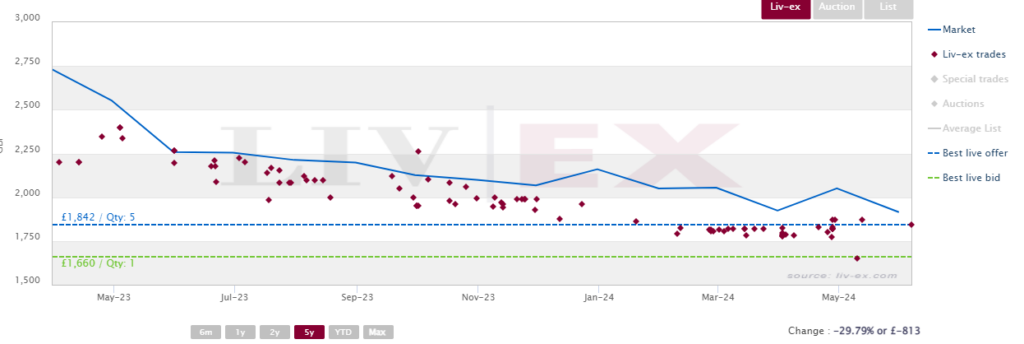
Likewise, Salon Le Mesnil Grand Cru 2013 made its international debut at £10,980 per 12×75 and has seen its Market Price fall since then, despite rave reviews from critics. It’s too early to tell how Krug 2011 will fare, but Pol Roger Sir Winston Churchill 2015, released in March 2023, is victim of the same fate.
Pol Roger Sir Winston Churchill 2015
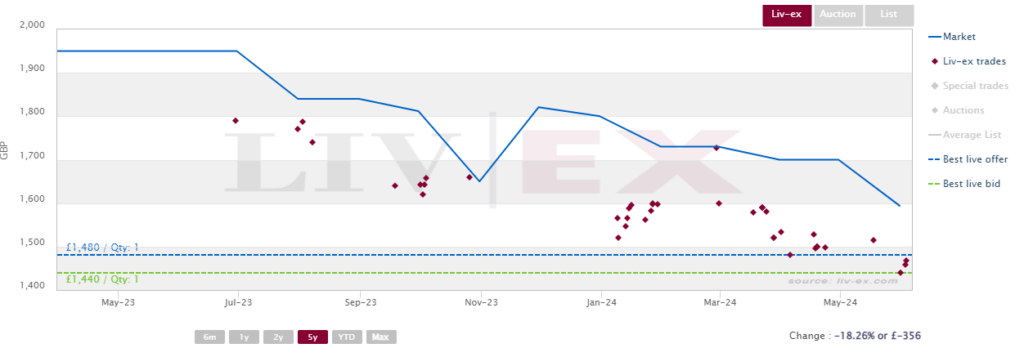
Most wines in the Champagne 50 are suffering from the hangover of 2022, when purse strings were loose and buyers were paying above-market prices for Champagne. Newer releases, however, those that have not benefited from this surge of demand and thus have no growth to cling on to, are simmering down gradually with no sign of imminent redemption.
